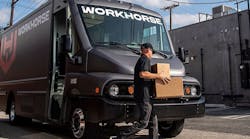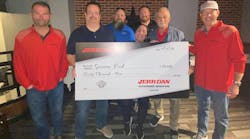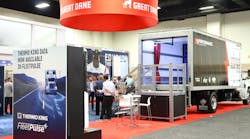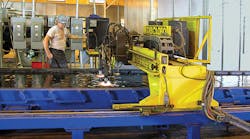TRUCK body and trailer manufacturers have more options than ever when it comes to cutting steel. Today's machine tool companies have made it easier to reduce scrap, make fabricating more efficient, and improve plant safety.
Lyle Menke, vice-president of marketing for Peddinghaus Corporation, listed a variety of things manufacturers and fabricators can consider to achieve those objectives.
Machine tool manufactures such as Peddinghaus are combining with plasma torch manufacturers and software companies to provide companies with sophisticated equipment. But in his presentation at last month's Fabtech International, Menke offered more things to consider than simply buying a plasma. Among them:
How much is a square foot of production space worth?
How do you handle material?
Can you do multiple processes with one pass?
How can you reduce scrap?
How can you make the workplace more ergonomic?
Much of Menke's presentation involved addressing the value of plant space.
“How much does your floor space cost per square foot?” Menke asked. “It may be $6.50-$7.00 per foot. That needs to be considered when bidding a job. If you have a cutting table that takes up 3,000 square feet inside your plant, that space will cost $20,000 or more per year.”
Some machines are now available that take up significantly less space. Menke also suggested storing steel outside the plant and using a conveyor to send plate through a small opening in an outside wall and feeding it directly into the machine. Move the plate from the outside storage location to the conveyor with a forklift. Such an arrangement takes up less space inside the plant, improves safety, and makes labor more productive.
“Moving something with an overhead crane is a spectator sport,” Menke said. “Every time a crane moves by, people stop to watch. Consider what that costs every year. If you use a roller conveyor to transport plate, people don't notice.
“Plus, cranes require more labor. How many people are required to move a steel plate by crane in your facility? If it's a 20-foot sheet, it's going to take at least two people.
“As one fabricator said, ‘I use the space under the roof that makes me money.’ We know of one company that stores all plate outside. Trucks come in, forklifts unload it, and the forklifts put the plate on the conveyor. The conveyor has motorized drives that move the plate through an opening in the building and feed it directly into the machine.”
Menke also suggested installing equipment on a mezzanine when possible.
Nesting on steroids
Menke took a long look at ways to get the absolute most from a plate of steel.
Nesting programs have been around for years to reduce scrap and speed up layout. Standard nesting programs produce skeletons as the plasma cuts parts from the sheet. However, it is now possible to nest parts together so closely that they can share common cut lines. The result all but eliminates the skeleton and significantly reduces scrap.
Menke cited an example of fabricating 13" × 13" base plates that contain a hole near each corner.
“Fabricators make zillions of these every year,” Menke said. “If you use standard nesting patterns to cut these from a plate of 96” steel, the scrap rate is almost 18%. If the plate costs $3,000, the scrap costs $530. But if you can nest the parts using common cut lines and some of the other options that are available, you can reduce scrap to less than 5%.”
Remnant nesting — the process of rotating the plate 90 degrees and running it through again to make more parts — can reduce the scrap rate even more.
Menke pointed out that skeletons are more than just material that is not used. They also represent the expenditure of time that does not directly add value for the customer.
“We have to get the plate off the table,” he said. “That typically requires a crane and an operator.”
Are we adding value?
Crane operators are one place manufacturers should look as they try to reduce labor costs. They may be costing more than you think.
“Normal costs for any employee include salary, benefits, insurance, and overhead,” he said. “We calculate that the ballpark cost today is around $50 per hour. If you can eliminate one person, that's about $100,000 per year off the bottom line. We aren't saying to fire anyone. Instead, train them to be a welder, an estimator, or something else that makes you money.”
Labor also should be used wisely because it is in such short supply. Menke mentioned a customer in Alberta Canada who is recruiting welders in Ireland.
“They are finding unemployed welders in Ireland and moving them to Alberta,” he said. “They are paying welders $30-$45 per hour. That is hour dire the labor shortage is.
Taking care of people
Plant safety is another factor to consider, and today's machine tools can help there, too.
“One of the things we have learned about tables is that there are some safety concerns,” Menke said. “Back injuries from bending over, finger injuries from removing or prying parts from the table. Sometimes you need liquid coolants to be able to handle parts after they have been cut. Small parts fall between slats. And what is the best way to contain chips?”
Parts discharge conveyors are available that capture the parts that are cut, yet allow the chips to fall into a collection hopper beneath the conveyor.
Menke concluded that today's manufacturing technology is more helpful than ever.
“Machine tools today are meant to be user friendly,” Menke said. “They now can compare the conditions against the parameters of the program. If an operator has the wrong type of material or the wrong tool in place, machines can detect it. Machine tool manufacturers are aware of the difficulty in getting operators, so we need to make it as easy as possible.”









